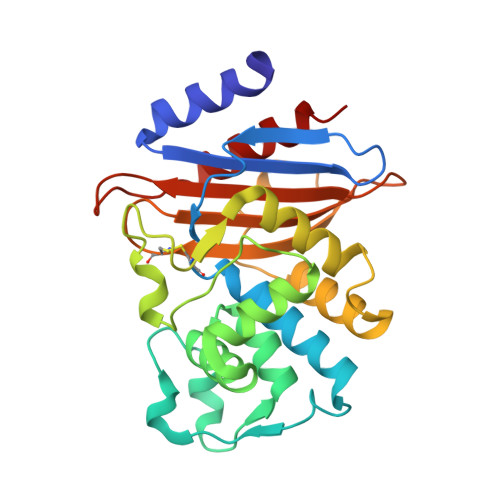Local interactions with the Glu166 base and the conformation of an active site loop play key roles in carbapenem hydrolysis by the KPC-2 beta-lactamase.
Furey, I.M., Mehta, S.C., Sankaran, B., Hu, L., Prasad, B.V.V., Palzkill, T.(2021) J Biological Chem 296: 100799-100799
- PubMed: 34022225
- DOI: https://doi.org/10.1016/j.jbc.2021.100799
- Primary Citation of Related Structures:
7LJK, 7LK8, 7LLB, 7LLH, 7LNL - PubMed Abstract:
The Klebsiella pneumoniae carbapenemase-2 (KPC-2) is a common source of antibiotic resistance in Gram-negative bacterial infections. KPC-2 is a class A ¦Â-lactamase that exhibits a broad substrate profile and hydrolyzes most ¦Â-lactam antibiotics including carbapenems owing to rapid deacylation of the covalent acyl-enzyme intermediate. However, the features that allow KPC-2 to deacylate substrates more rapidly than non-carbapenemase enzymes are not clear. The active-site residues in KPC-2 are largely conserved in sequence and structure compared with non-carbapenemases, suggesting that subtle alterations may collectively facilitate hydrolysis of carbapenems. We utilized a nonbiased genetic approach to identify mutants deficient in carbapenem hydrolysis but competent for ampicillin hydrolysis. Subsequent pre-steady-state enzyme kinetics analyses showed that the substitutions slow the rate of deacylation of carbapenems. Structure determination via X-ray diffraction indicated that a F72Y mutant forms a hydrogen bond between the tyrosine hydroxyl group and Glu166, which may lower basicity and impair the activation of the catalytic water for deacylation, whereas several mutants impact the structure of the Q214-R220 active site loop. A T215P substitution lowers the deacylation rate and drastically alters the conformation of the loop, thereby disrupting interactions between the enzyme and the carbapenem acyl-enzyme intermediate. Thus, the environment of the Glu166 general base and the precise placement and conformational stability of the Q214-R220 loop are critical for efficient deacylation of carbapenems by the KPC-2 enzyme. Therefore, the design of carbapenem antibiotics that interact with Glu166 or alter the Q214-R220 loop conformation may disrupt enzyme function and overcome resistance.
Organizational Affiliation:
Department of Pharmacology and Chemical Biology, Baylor College of Medicine, Houston, Texas, USA.

















